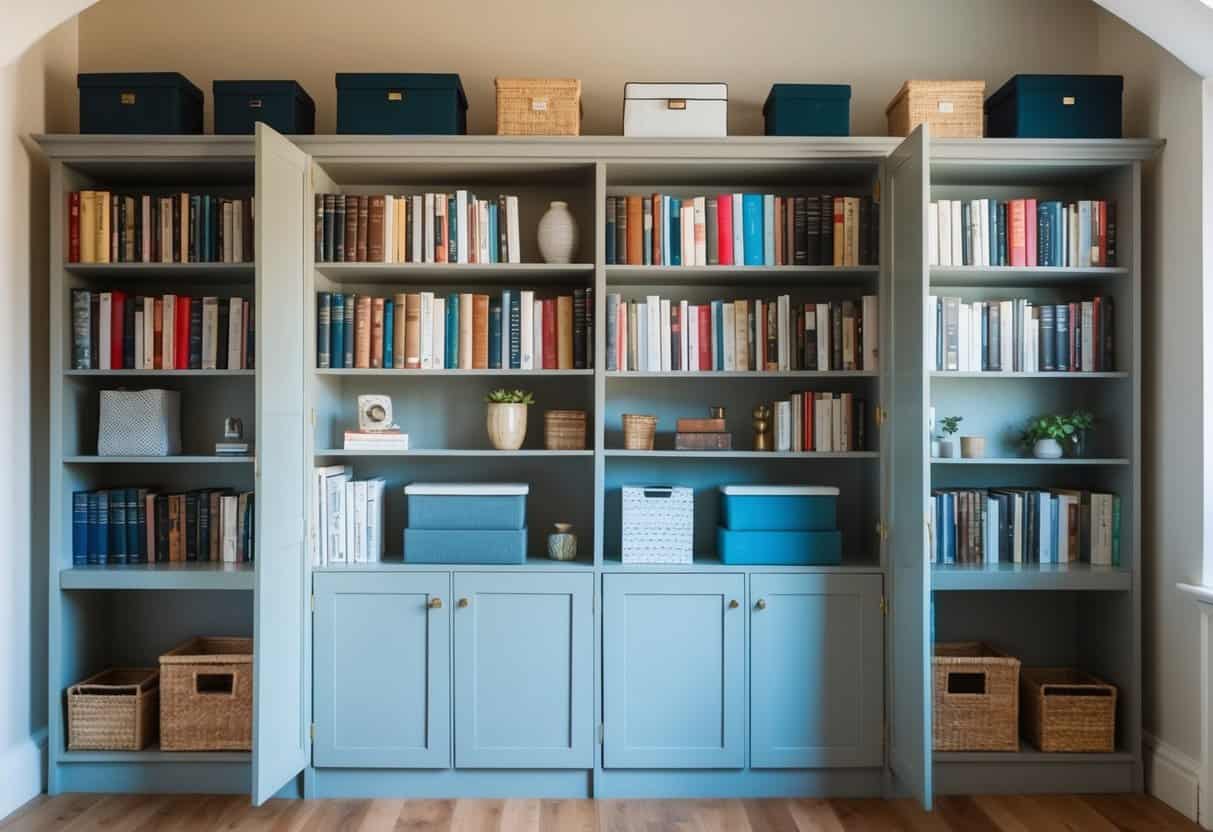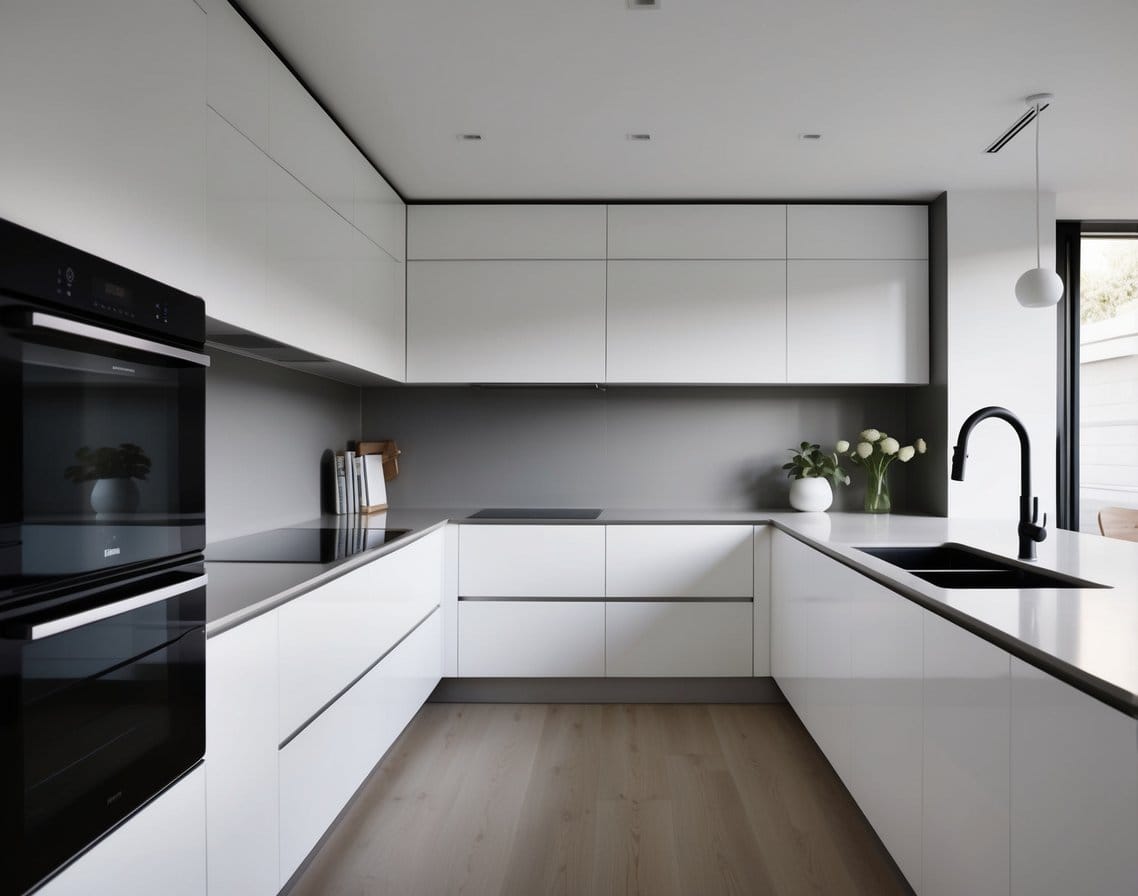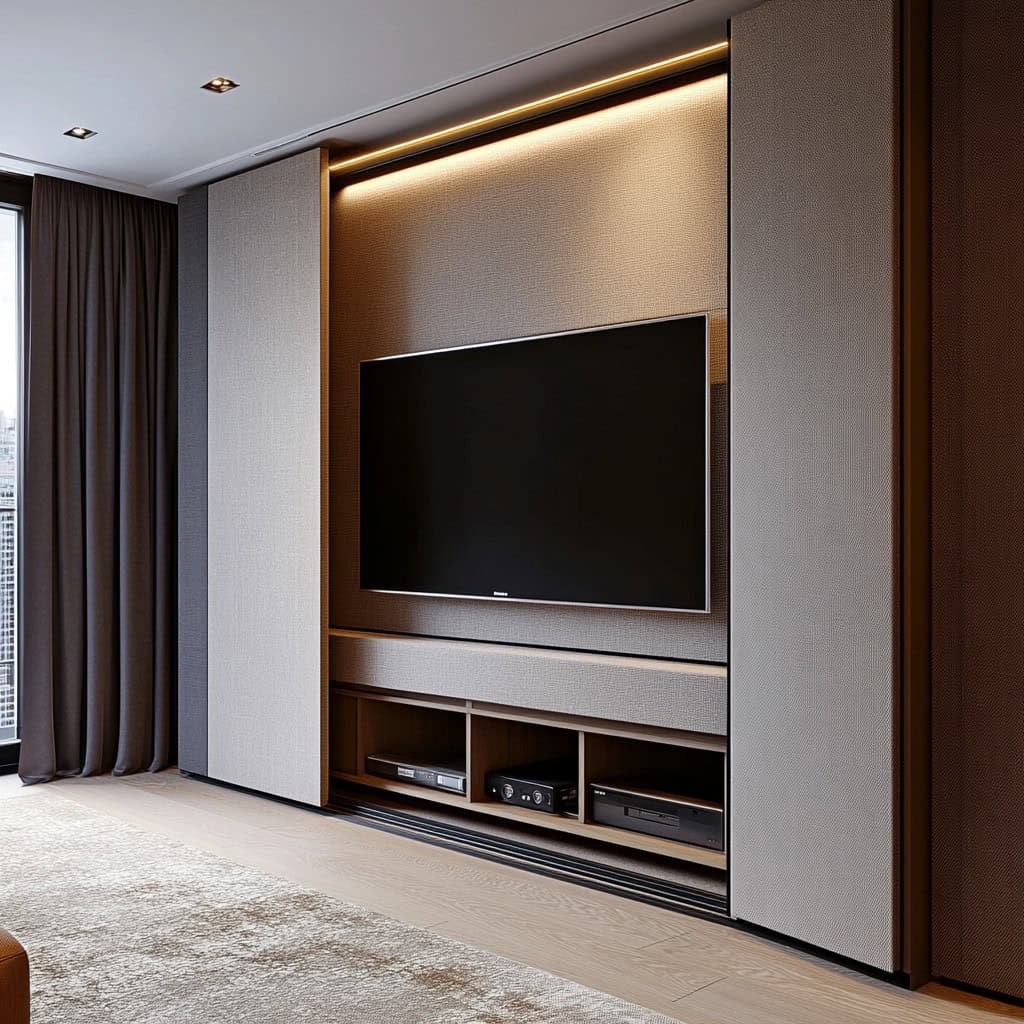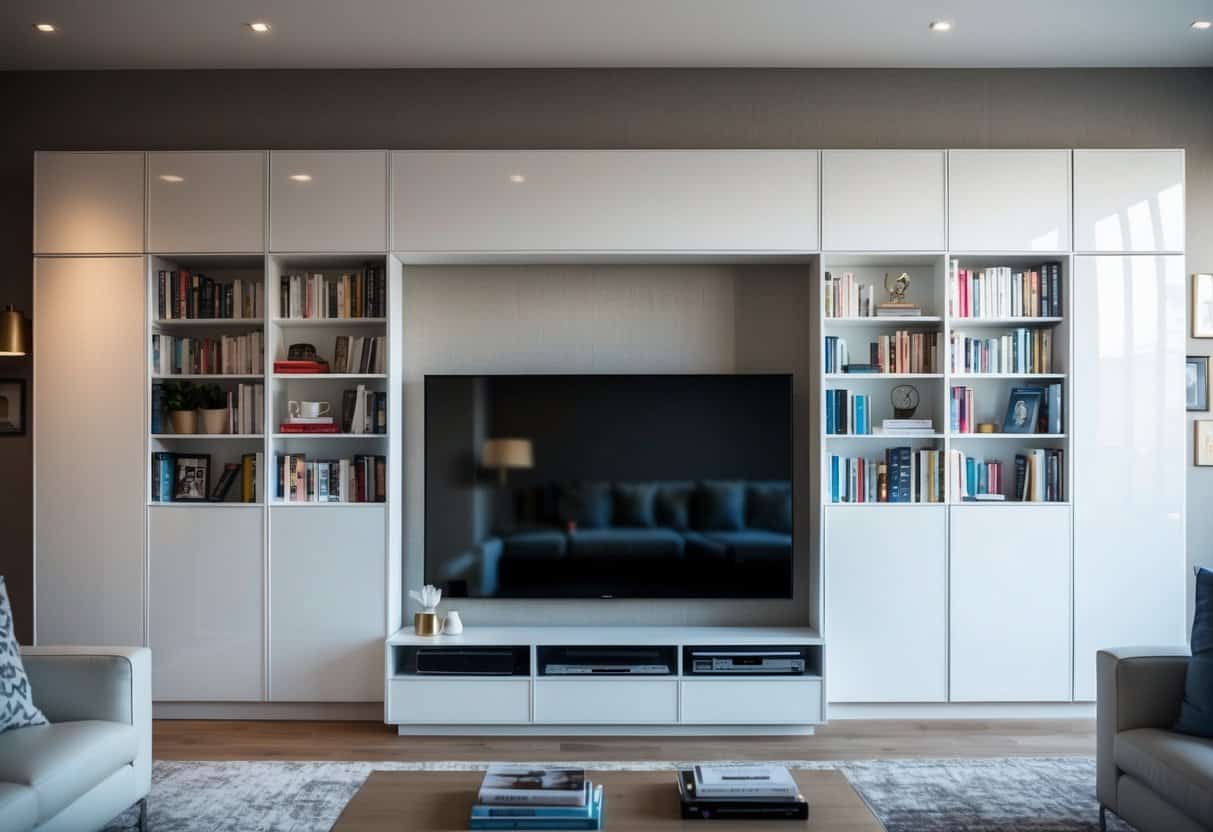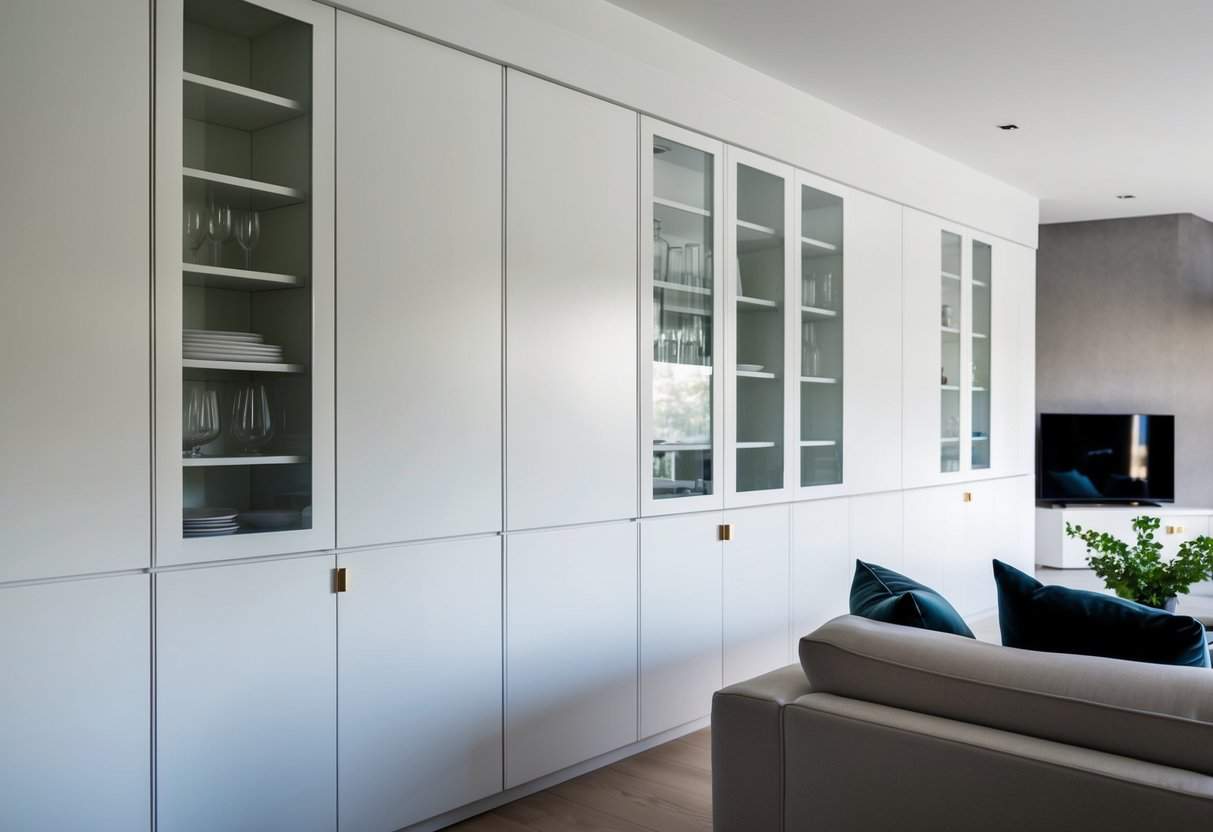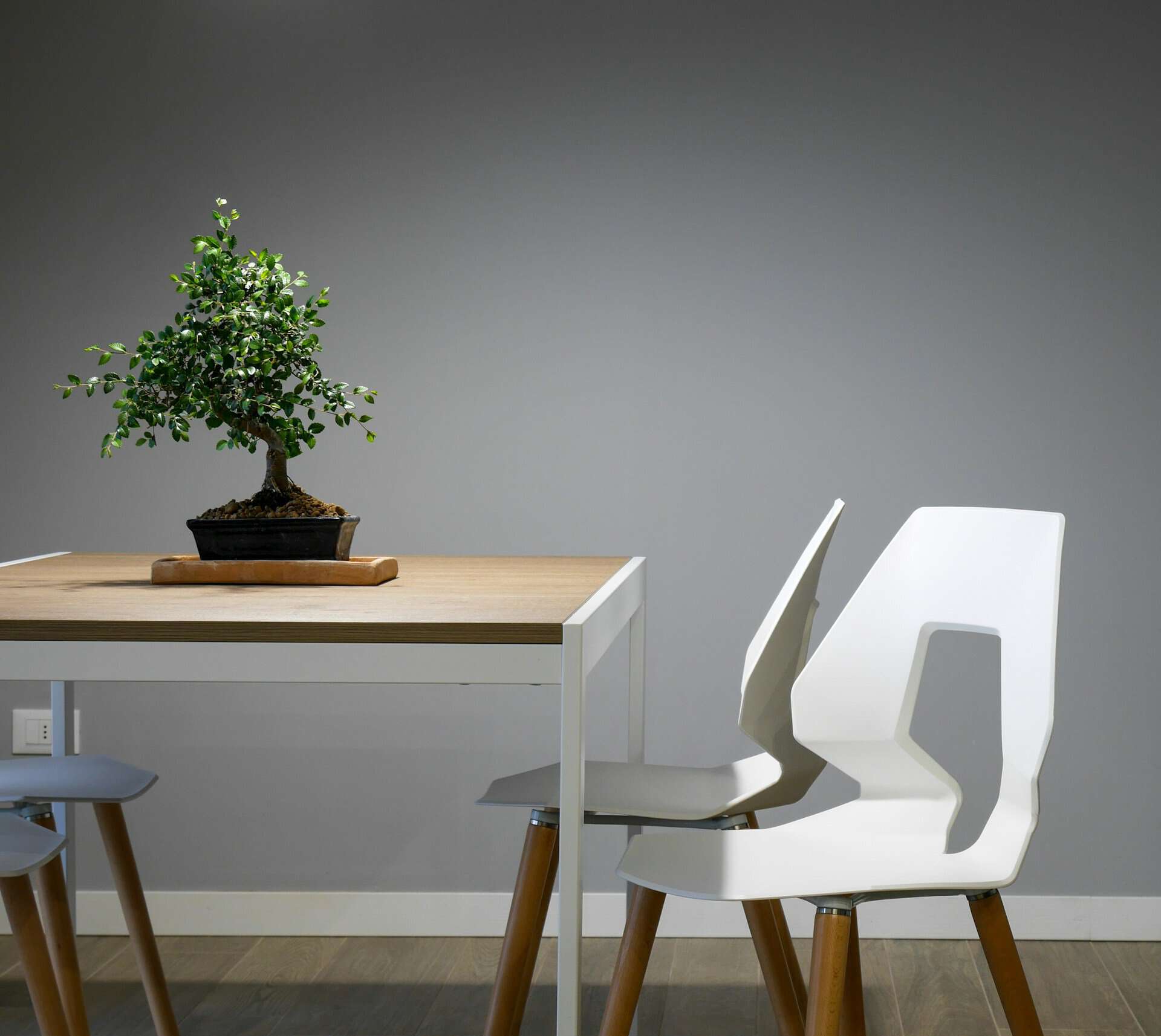Under sink cabinets are a game-changer for bathroom organization. These handy storage units fit snugly beneath your sink, making use of often wasted space. They come in various styles and sizes to match different sink types and bathroom decor.

Under sink cabinets offer practical storage solutions while keeping your bathroom tidy and clutter-free. We love how they hide unsightly pipes and provide a clean, finished look to your bathroom. Some models even feature adjustable shelves, allowing you to customize the storage space to fit your needs.
When choosing an under sink cabinet, it’s important to measure your space carefully. Many designs, like the Kleankin Pedestal Under-sink Cabinet, have a U-shaped cut-out to accommodate plumbing. This smart design ensures a perfect fit around your sink’s pedestal or pipes.
Key Takeaways
- Under sink cabinets maximize bathroom storage space and hide plumbing
- Various styles and sizes are available to fit different sinks and decor
- Proper measurements are crucial for selecting the right cabinet for your space
Types of Under Sink Cabinets
We can find several types of under sink cabinets to fit different spaces and needs. These cabinets help us make the most of the area beneath our sinks, offering smart storage solutions for bathrooms and kitchens.
Bathroom Under Sink Cabinets
Bathroom under sink cabinets come in various styles to suit different layouts. Pedestal sink cabinets wrap around the base of a pedestal sink, making use of otherwise wasted space. These cabinets often have a U-shaped design to accommodate plumbing.
For vanity sinks, we can choose cabinets with drawers or shelves. Some models feature pull-out trays for easy access to items at the back. Tall cabinets work well in bathrooms with more vertical space.
We can find cabinets made from water-resistant materials like plastic or treated wood. This helps protect our belongings from moisture. Many bathroom cabinets come in white or light colors to match common bathroom decor.
Kitchen Under Sink Cabinets
Kitchen under sink cabinets offer more storage options due to their larger size. We can install pull-out trays to maximize space and keep items organized. These trays slide out for easy access to cleaning supplies or trash bins.
Some kitchen cabinets have built-in organizers for sponges, dish soap, and other cleaning tools. We can also add hooks to the inside of cabinet doors for hanging gloves or towels.
Tip-out trays at the top of the cabinet are great for small items like sponges or scrub brushes. For deep cabinets, we might consider lazy Susans to make use of corner spaces and reach items more easily.
Corner Under Sink Cabinets
Corner under sink cabinets require special designs to make the most of awkward spaces. L-shaped cabinets fit snugly into corners, often with angled doors for better access.
We can find corner cabinets with rotating shelves or pull-out systems. These allow us to reach items tucked away in the back corners. Some designs feature diagonal drawers that open at an angle.
For tight spaces, compact corner cabinets with a single door can still provide valuable storage. We might add small organizers or bins inside to keep things tidy in these smaller cabinets.
Design Features
Under-sink cabinets come in various designs to fit different needs and spaces. Key features include material choice, shelf options, weight capacity, and drawer configurations.
Material and Durability

We find that under-sink cabinets are made from several materials. Wood is a classic choice, offering a warm look and good durability. Particleboard with a laminate finish is budget-friendly but less water-resistant.
For bathrooms and kitchens, we recommend water-resistant materials. Metal cabinets, especially stainless steel, resist rust and are easy to clean. Plastic cabinets are lightweight and won’t corrode.
Cabinet durability depends on material quality and construction. Look for reinforced corners and sturdy hinges. Water-resistant finishes or sealed edges help protect against moisture damage.
Adjustable Shelves
Adjustable shelves are a key feature in many under-sink cabinets. They allow for customization of storage space to fit various item sizes.
We find that most adjustable shelves use pegs or clips inserted into pre-drilled holes. This system lets you move shelves up or down as needed.
Some cabinets offer pull-out shelves for easier access to items at the back. These can be particularly useful for storing cleaning supplies.
When choosing a cabinet with adjustable shelves, check the number of adjustment levels. More levels mean greater flexibility in organizing your space.
Weight Capacity
Weight capacity is crucial for under-sink cabinets, especially in kitchens where heavy pots or cleaning supplies are stored.
We recommend checking the weight limit for each shelf. This usually ranges from 20 to 50 pounds per shelf for standard cabinets.
The cabinet’s overall weight capacity matters too. This depends on material strength and construction quality.
For heavy items, look for cabinets with reinforced bottoms or additional support brackets. Metal cabinets often have higher weight capacities than wood or particleboard options.
With or Without Drawers
Under-sink cabinets come in designs with and without drawers. Each has its advantages.
Drawers offer easy access and organization for smaller items. They’re great for sorting cleaning supplies or bathroom essentials.
We find that pull-out drawers are particularly useful. They let you see and reach items at the back without bending down.
Cabinets without drawers provide open storage. This works well for larger items or when you need to fit around plumbing fixtures.
Some designs combine open shelves with drawers. This gives you the best of both worlds, allowing for versatile storage options.
Dimensions and Fit
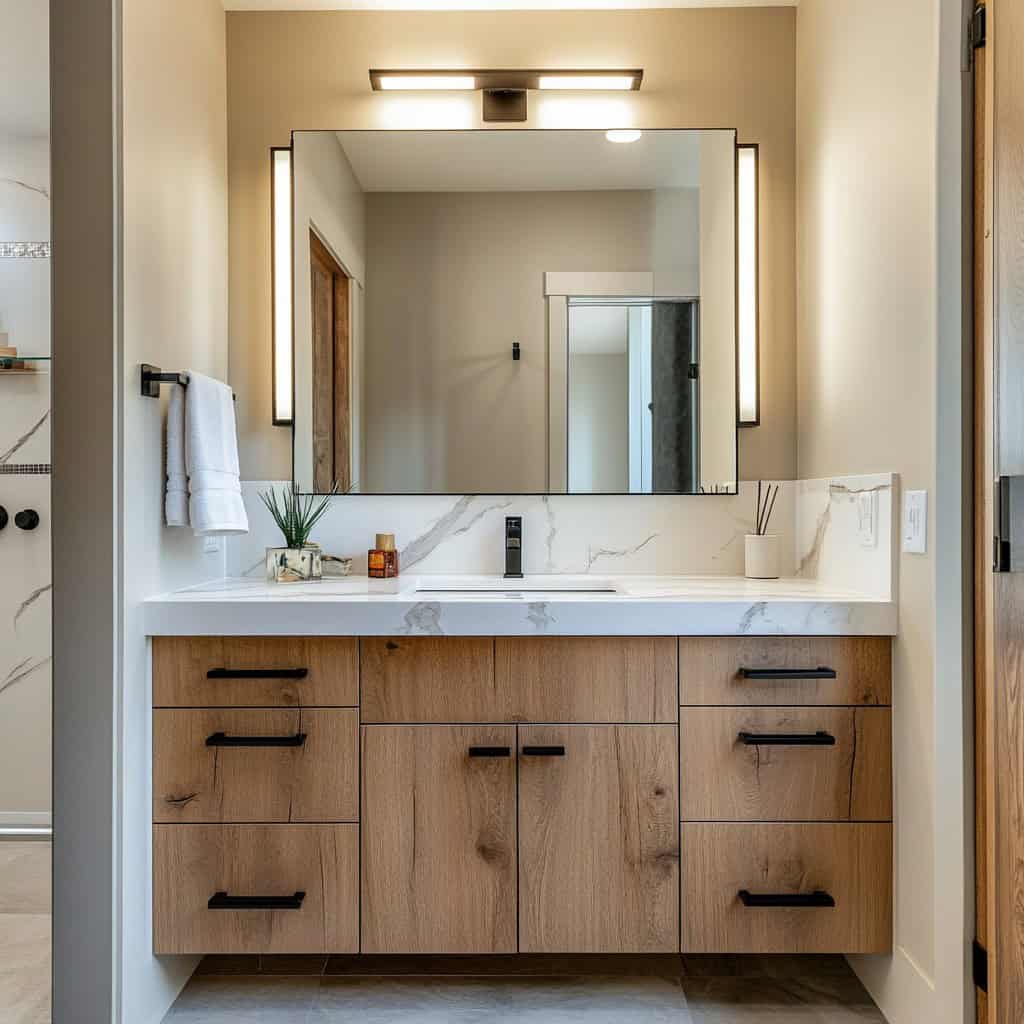
Getting the right dimensions for your under sink cabinet is crucial. We’ll cover how to measure your space and find the perfect size.
Measuring Your Space
To start, we need to measure the area under your sink. Grab a tape measure and note down the width, depth, and height of the space. Don’t forget to account for any pipes or fixtures.
The standard height for base cabinets is 34.5 inches without the countertop. With the countertop, it’s usually 36 inches.
For width, common sizes are 30, 33, and 36 inches. Measure carefully to ensure a proper fit.
Depth is typically 24 inches for base cabinets. This allows enough room for sinks and plumbing while maximizing storage space.
Finding the Right Size
Once we have our measurements, we can choose the right cabinet size. Sink base cabinets come in standard widths of 30, 33, and 36 inches.
For a single bowl sink, a 30-inch cabinet often works well. Double bowl sinks may require a 33 or 36-inch cabinet.
Remember to leave some wiggle room. We recommend choosing a cabinet slightly smaller than your available space for easy installation.
Consider space-saving options like pull-out organizers or adjustable shelves. These can help maximize storage in smaller cabinets.
Always check the sink dimensions too. The sink should be about 3 inches smaller than the cabinet width for a proper fit.
Assembly and Installation
Under sink cabinets require careful assembly and installation to ensure proper fit and functionality. Let’s explore the key steps and tips for putting together and setting up your cabinet.
Assembly Tips
We recommend starting with a clear workspace and sorting all parts before beginning. Check the instructions carefully to identify each component.
Group similar pieces together to stay organized. Keep screws and small hardware in labeled containers to avoid mix-ups.
Use the right tools for the job. A screwdriver, level, and measuring tape are essential. Some cabinets may require a power drill for faster assembly.
We suggest enlisting a helper for large or heavy pieces. This makes alignment easier and reduces the risk of damage.
Take your time with each step. Rushing can lead to mistakes or improper fit. Double-check connections before moving on to ensure stability.
Installation Guide
Before installation, we need to prepare the space. Remove any old cabinets or fixtures and clean the area thoroughly.
Measure the space carefully. Mark the position for the cabinet on the wall using a level to ensure it’s straight.
If your cabinet attaches to wall studs, locate and mark these. Use a stud finder for accuracy. For drywall installation, choose appropriate anchors.
We recommend starting with the cabinet frame. Secure it to the wall, checking for level as you go. Adjust as needed before fully tightening screws.
Next, install shelves and doors according to the manufacturer’s instructions. Test doors and drawers to ensure smooth operation.
Finally, caulk any gaps between the cabinet and wall for a polished look. Allow sufficient drying time before using the cabinet.
Storage Optimization
Under-sink cabinets offer valuable storage potential. We’ll explore smart ways to maximize space and use organizational accessories to create an efficient storage system.

Maximizing Space
To make the most of under-sink storage, we recommend using every inch wisely. Install a tension rod across the cabinet to hang spray bottles, freeing up floor space. Stack clear bins to utilize vertical space effectively.
Consider pull-out drawers or sliding organizers to access items at the back easily. Use the inside of cabinet doors by attaching hooks or small baskets for extra storage.
We suggest grouping similar items together in labeled containers. This keeps things tidy and makes finding what you need quick and simple.
Organizational Accessories
The right accessories can transform your under-sink area. We recommend clear storage bins for a uniform look and easy item identification. Lazy Susans work well for corner spaces, allowing quick access to all items.
Over-the-door organizers maximize unused space. They’re perfect for storing cleaning supplies or beauty products in bathroom cabinets.
For plumbing workarounds, try U-shaped shelves that fit around pipes. These clever solutions let you use space that would otherwise go to waste.
Drawer dividers keep smaller items organized and prevent them from rolling around. We find them especially useful for storing tools or extra toiletries.
Maintenance and Care
Keeping your under sink cabinet clean and well-maintained is key to its longevity and function. Regular upkeep prevents damage and ensures the space stays organized and fresh.

Cleaning Your Cabinet
We recommend cleaning your under sink cabinet every few months. Start by taking everything out and wiping down the surfaces with a damp cloth. For tougher stains, mix warm water with mild dish soap.
Use an old toothbrush to scrub corners and edges. Avoid harsh chemicals that can damage the cabinet finish. Instead, try baking soda and vinegar for stubborn spots.
Don’t forget to clean the pipes and check for leaks. Wipe them down and look for any signs of water damage or mold. If you spot issues, call a plumber right away.
Let the cabinet dry completely before putting items back. This prevents moisture buildup and keeps things fresh.
Long-Term Upkeep
For long-term care, we suggest adding protective measures. Place a liner on the cabinet floor to catch spills and make cleaning easier.
Check the hinges and handles every few months. Tighten loose screws and oil squeaky parts. This keeps the cabinet working smoothly.
Watch out for signs of water damage or warping. Fix leaks promptly to prevent serious harm. Consider using a dehumidifier or moisture absorber in damp areas.
Organize items in bins or on tension rods to prevent clutter. This makes cleaning easier and helps you spot issues faster.
Replace old or worn items regularly. Keep cleaning supplies in good condition and toss expired products. This keeps your space safe and functional.
Environmental Considerations
Under-sink cabinets can be made more eco-friendly through careful material selection and sustainable practices. We’ll explore options that reduce environmental impact without sacrificing quality or functionality.

Eco-Friendly Materials
Environmentally friendly cabinets use sustainable materials that minimize harm to nature. We recommend bamboo, which grows quickly and regenerates easily. Reclaimed wood is another great choice, giving new life to old materials.
For finishes, we suggest low-VOC or no-VOC paints and sealants. These reduce harmful emissions in your home. Water-based finishes are also a good option.
Some manufacturers now offer cabinets made from recycled materials. These can include recycled wood fibers or even recycled plastic. They’re durable and help reduce waste.
Sustainability Practices
We can make under-sink cabinets more sustainable through smart design and manufacturing. Using precise measurements and cutting techniques reduces waste during production. This approach saves materials and energy.
Efficient waste management is key. We encourage recycling or repurposing wood scraps and sawdust. Some can be used for particle board or as fuel.
Energy-efficient tools and processes help too. LED lighting in workshops uses less power. Solar panels can provide clean energy for production facilities.
Choosing local materials cuts down on transportation emissions. It also supports local economies. We believe in sourcing wood from certified sustainable forests when possible.
Frequently Asked Questions
Under sink cabinets offer storage and organization options for bathrooms and kitchens. These cabinets come in various sizes and styles to fit different spaces and needs.
What are the dimensions for a standard under sink cabinet in both kitchens and bathrooms?
Standard kitchen under sink cabinets are usually 36 inches wide, 24 inches deep, and 34.5 inches tall. Bathroom under sink cabinets tend to be smaller, typically 30-48 inches wide, 18-21 inches deep, and 32-36 inches tall.
These dimensions can vary based on the sink size and room layout. We recommend measuring your space before purchasing a cabinet.
How can one optimize storage in an under sink cabinet with drawers?
To maximize storage in an under sink cabinet with drawers, we suggest using drawer organizers. These help separate items and make them easy to find.
Pull-out shelves or sliding baskets can also help utilize the full depth of the cabinet. Consider using the back of cabinet doors for additional storage with over-the-door organizers.
What are some creative ideas for organizing an under sink bathroom cabinet?
For bathroom under sink cabinets, we recommend using clear plastic bins to group similar items. Lazy Susans work well for storing small bottles and jars.
Tension rods can create extra storage for spray bottles. Magnetic strips on the inside of cabinet doors can hold metal items like tweezers and nail clippers.
What are the considerations when choosing a non-pedestal under sink cabinet?
When selecting a non-pedestal under sink cabinet, consider the size of your bathroom and available space. Think about the cabinet material and its ability to withstand moisture.
Look for cabinets with adjustable shelves for flexibility. Check that the cabinet can accommodate your plumbing and has cutouts for pipes if needed.
How can you integrate an under sink cabinet into a small bathroom space efficiently?
In small bathrooms, we suggest choosing a compact under sink cabinet that fits snugly around the plumbing. Wall-mounted cabinets can create the illusion of more floor space.
Consider cabinets with mirrors or open shelving above to maximize vertical space. Light colors can make the bathroom feel larger and more open.
What factors should be taken into account when selecting an under sink cabinet from IKEA?
When choosing an IKEA under sink cabinet, measure your space carefully. Check if the cabinet is compatible with your existing sink or if you need to buy a new one.
Consider the cabinet’s material and finish. Look at the storage options, such as drawers or shelves. Review assembly requirements and ensure you have the necessary tools.



